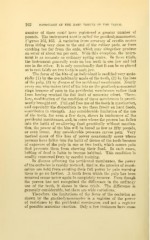Page 292 - My FlipBook
P. 292
162 PATHOLOGY OF THE HAED TISSUES OF THE TEETH.
number of these could have registered a greater number of
pounds. The instrument used is called the gnathodynaruoineter.
Figures 162, 163. A variation from accuracy of results occurs
from biting very close to the end of the rubber pads, or from
catching too far from the ends, which may altogether produce
an error of about ten per cent. AVith this exception, the instru-
ment is as accurate as ordinary spring scales. In these trials,
the instrument generally rests on two teeth in one jaw and but
one in the other. It is only occasionally that it can be so placed
as to rest fairly on two teeth in each jaw.
The force of the bite of an individual is modified very mate-
rially (1) by the use habitually made of the teeth, (2) by the loss
of the pulp, (3) by disease of the peridental membranes. Nearly
every one who makes trial of his bite on the gnathodynamometer
stops because of pain in the peridental membranes rather than
from having reached the full limit of muscular effort. There-
fore, modification of the condition of these membranes is promi-
nently brought out. Full and free use of the teeth in mastication,
and especially the disposition to use them freely on hard foods,
contributes to strength. Any considerable limitation of the use
of the teeth, for even a few days, shows in tenderness of the
peridental membranes, and, in cases where the person has fallen
into the habit of swallowing food practically without mastica-
tion, the power of the bite will be found as low as fifty pounds,
or even lower. Any considerable pressure causes pain. Very
marked cases of this loss of power occasionally occur where
persons have fallen into the habit of disuse of the teeth because
of exposure of the pulp in one or two teeth, which causes pain
that prevents them from chewing their food. In such cases,
bolting of food is liable to become habitual. This condition is
readily recovered from by careful training.
In disease affecting the peridental membranes, the power
of the occlusion is rapidly reduced; that is, the muscles of masti-
cation are held from exerting their full power by pain warning
them to go no farther. A tooth from which the pulp has been
removed seems never again to completely recover. Even though
the person has not recognized the difference in the ordinary
use of the teeth, it shows in these trials. The difference is
generally considerable, but there are wide variations.
Therefore, the limitations of the force of the occlusion as
shown by the gnathodynamometer is a register of the power
of resistance by the peridental membranes and not a register
of possible muscular exertion. Only a few instances have come


